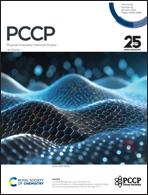Electronic and elastic properties of metastable Zr3N4: a joint experimental and theoretical study†
Abstract
The electronic structures and elastic properties of metastable Zr3N4 phases have been investigated using the first-principles calculations with the Heyd–Scuseria–Ernzerhof (HSE06) hybrid functional, in comparison with those of the stable ZrN phase. All three metastable Zr3N4 phases (including orthorhombic, spinel and Th3P4-type phases) are found to be semiconducting with bandgaps of 1.72–1.94 eV. In particular, the computationally indirect bandgap of 1.72 eV of orthorhombic Zr3N4 is consistent with the experimental value of 1.8 eV. The detailed analyses of the electronic structures reveal that the change of electrical conductivity from metallic ZrN to semiconducting Zr3N4 is mainly due to the electron transfer from Zr to N atoms, which weakens the Zr–Zr interactions and reduces the proportion of metallic bonding. In addition, the elastic properties of Zr3N4 and ZrN phases have been calculated. The theoretical hardness values of ZrN and orthorhombic Zr3N4 are 18.06 and 6.98 GPa, respectively, agreeing well with the experimental values of 19.26 and 7.90 GPa. This work may further promote the understanding of the promising Zr–N material system.



 Please wait while we load your content...
Please wait while we load your content...